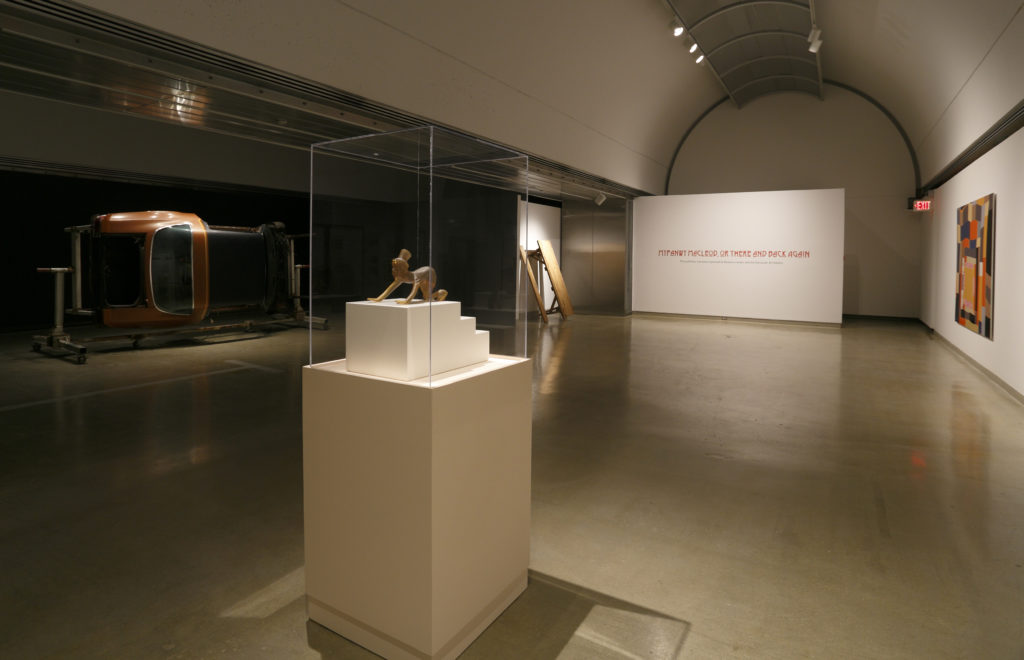For those of a certain age, there’s something timeless about muscle cars, pin-up models and Led Zeppelin. Growing up in the 1970s, these were the touchstones of cool culture, where revving engines, feathered hair and grinding riffs fuelled many adolescent fantasies on both sides of the gender divide.
Yet as emblematic as those macho models may be of a particular time and place, they’re also tinged with a bittersweet echo. The energy crisis and a rising feminist voice were among the tidal shifts in the era’s dominant social realities that ushered in lasting changes to the personal and political order. As for Led Zeppelin, a pinnacle of excess lead to the band’s demise in 1980.
That discordant sense of nostalgia as both fond memory and fraught reality runs through “Myfanwy MacLeod, or There and Back Again,” a survey of works by the Vancouver-based artist that closes this weekend at Museum London.
The show (which travels to the Vancouver Art Gallery in 2014) is a homecoming of sorts for MacLeod, who was born in London in 1961 and spent her formative teenage years there. Drawing on works from 2000 to the present, and including a number of large-scale pieces produced specifically for the show, the exhibition runs the gamut of MacLeod’s practice, which has long been marked by wry strikes at pop culture and contemporary art.
This is more than just a recap, though. Curator Cassandra Getty and MacLeod have crafted a show that cleverly repositions the artist’s work as a kind of drifting narrative based on MacLeod’s 1970s London youth, both remembered and imagined. It’s a trip down memory lane charged with humour (the 70s make a ripe target for that) but also an unmistakable undertone of wistful melancholy and even foreboding that lends the work and the show an almost trenchant personal edge.
Getty and MacLeod have made good use, too, of Museum London’s long, hall-like galleries, weaving their narrative back and forth through a plethora of what seem like subtle formal coincidences between works, and along sprawling gallery sightlines.
Take, for instance, MacLeod’s cedar picnic table, A Shady Place (2002), (complete with “Myfanwy was here” carved in an elaborate high-school doodling script) which leans upright against a gallery wall in the exhibition’s opening room. It’s a sculptural memory cue echoed in the adjacent Small Landscapes (2005) drawings, which depict various summer holiday scenes (many that include picnic tables) copied from 1970s-era family snapshots and drawn with fading effect.
In another room, MacLeod’s suite of Hex paintings (2009), which feature the patterned charm symbols found on country barns, are mirrored in the opposite gallery by Stacks (2013), an imposing grid of 18 super-sized screenprints of the front faces of Marshall guitar amplifiers. Add to this her composite take on the formal geometries of modernist painting in Ain’t nothing ever happened (2009) (hung in the opening gallery), or her pattern-cut 1970s/80s pop-star poster works Michael, Carrie and Rosemary (all 2010), which close the show, and you have a multi-tiered play on the mystical lexicons of high and low culture cast with a distinct retro vibe.
For all of its back-and-forth playfulness, the exhibition does divert into more serious territory in a gallery filled with cut-and-folded sculptures and photo works based on the tragic tale of BC-born 1970s pin-up model, Playboy bunny and actress Dorothy Stratten. Here the feathered glamour and macho bravado of the era is thoroughly flattened. And the placement of MacLeod’s sheet-draped child mannequin sculpture Ghost (2006) in the exhibition’s closing room (though you do catch its spectral form in glimpses throughout the gallery) lends an eerie finality to the show.
But perhaps the most telling metaphor for all of the meanings and memories at play in the exhibition comes by way of Ramble On (Camaro) (2013). For it, MacLeod rescued a long abandoned 1977 Camaro Rally Sport—a classic in the world of muscle cars—that had once belonged to her brother. Installed rotisserie-like on its side in the gallery, it’s a sad shell of what was once a potent machine, its high-octane symbolic power now perfumed with the toxic smell of rust and rot.
Maybe someone hoped to rebuild it someday? To restore the dream destroyed by time and age? Those are questions left pointedly unanswered by MacLeod. She seems to leave that up to the motivational voice of an exercise coach that bleeds in from her installation Don’t Stop Dreaming (2004) in a neighbouring gallery: “Find the strength, find determination in your body, the commitment in your mind…breathe, think…amp it up again, make it look easy, make your time worthwhile while you’re here.”









